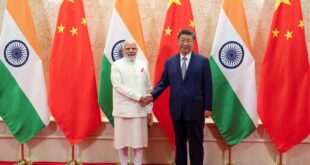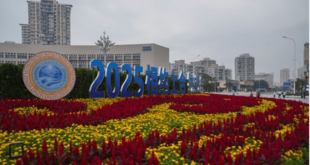The Islamic State of Iraq and the Levant ISIL/ISIS is a covert western army designed to carve out a Sunni mini-state in a chaotic Middle East, which is to be fractured along artificial sectarian and ethnic lines.
Iraq has been plunged into a further state of chaos over the past fortnight, as ISIL mercenaries have launched attacks against the Iraqi Army in numerous towns in the Northwest of the country. ISIL is a group of foreign mercenaries supported by the west which has committed what “almost certainly amounts to war crimes” in Iraq, according to the UN Human Rights Chief Navi Pillay. The Sunni dominated ISIL has long been used by western powers in neighbouring Syria to destabilise and destroy the Bashar al-Assad regime in Damascus, which refuses to be absorbed into the western economic-corporate empire.
Western imperial powers have used a policy of divide and conquer, coupled with chaos, to fracture regimes along sectarian and ethnic lines in order to destroy nation states that resist Anglo-American-European hegemony. Iraq is part of a wider strategy for the Middle East which is advocated by western geopolitical strategists Zbigniew Brzezinski and Bernard Lewis. Historian and author Webster Tarpley crystallises the Brzezinski-Lewis blueprint for a “New Middle East” during an interview in 2012:
“The US strategic goal in the Middle East is the destruction of all existing national states. There’s an outline for this that has been known for many years as the Bernard Lewis plan, [and] it’s been expressed again by people like Zbigniew Brzezinski; micro states, mini-states, rump-states, secessionism, chaos, war lords and NATO feels free to seize whatever assets they think are important.” (3:29 into the interview)
Bernard Lewis gave a glimpse into the strategy of western powers in an article published in the 1992 issue of “Foreign Affairs” titled: Rethinking the Middle East, where he outlines the possibility of a future Middle East comprised of warring sects and tribes:
“Another possibility, which could even be precipitated by fundamentalism, is what has of late become fashionable to call “Lebanonization.” Most of the states of the Middle East—Egypt is an obvious exception—are of recent and artificial construction and are vulnerable to such a process. If the central power is sufficiently weakened, there is no real civil society to hold the polity together, no real sense of common national identity or overriding allegiance to the nation state. The state then disintegrates—as happened in Lebanon—into a chaos of squabbling, feuding, fighting sects, tribes, regions and parties. If things go badly and central governments falter and collapse, the same could happen, not only in the countries of the existing Middle East, but also in the newly independent Soviet republics, where the artificial frontiers drawn by the former imperial masters left each republic with a mosaic of minorities and claims of one sort or another on or by its neighbours.”
As Tony Cartalucci has reported for New Eastern Outlook, ISIL is a creation of the US and its Sunni Gulf Monarch allies in the region. It is designed to create a Sunni Islamic state within Iraq and increase sectarian tensions across the Middle East which will weaken the Shia powers of Iran, Syria and Hezbollah. World Net Daily has also received leaks from Jordanian officials which reveal that the US military trained the militants in secret bases inside Jordan in 2012, to then be deployed to fight against the regime in Syria. ISIL has been destabilising Iraq for years and in March the Iraqi Prime Minister Nouri al-Maliki asserted that Saudi Arabia and Qatar were funding the ISIL to weaken the government in Bagdad. In the run up to the Iraqi elections in April, ISIL was fighting in the western Anbar region of Iraq which resulted in approximately 300 deaths in February.
The official narrative propagated from the mainstream media is that Iraq is experiencing a bloody civil war that has erupted out of deep sectarian divisions that have existed for decades. Yet it has been documented at length that the main group that has been perpetuating the violence within Iraq – namely ISIL – is controlled by the west and their regional allies. A recent article in the Guardian newspaper by Iraqi refugee and Sociology lecturer at London Metropolitan University, Sami Ramadani, describes the absence of sectarian violence in Iraq prior to the invasion in 2003. He describes how sectarian violence only became a problem after the invasion, and believes that the colonial strategy of divide and rule has been used in Iraq to fragment the country into 3 regions based along sectarian lines.
The agenda of Iraq being divided into 3 separate regions has been the policy of western imperious powers for decades, with a map released in 2006 by retired general of the U.S. National War Academy Lieutenant-Colonel Ralph Peters depicting Iraq split into 3 regions; a Sunni Iraq to the West, a Arab Shia State in the East and a Free Kurdistan in the North.

As well as a controlled Sunni group capturing much of western Iraq in recent weeks, the prescient 2006 strategy outlined in the map is further supported by the Kurdish fighters in Syria carving out an independent region in the northeast of Syria. In January the Syrian Kurds declared an autonomous region which could see the creation of a Free Kurdistan in the Middle East, especially if it is merged with Iraqi Kurdistan in Northern Iraq next door.
Imperious powers have always feared a strong, unified and cohesive people who can form organised resistance movements to oppose colonial forces. Classical divide and conquer doctrine has been implemented in the Middle East over the previous few decades in order to engineer a state of chaos which destroys nation states. Destabilisation, chaos and balkanisation is the policy of today, which weakens regimes who are hostile to western geostrategic interests and allows multinational corporations to rape the region of its resources.
Writes: Steven MacMillan
 Geostrategic Media Political Commentary, Analysis, Security, Defense
Geostrategic Media Political Commentary, Analysis, Security, Defense






You must be logged in to post a comment.